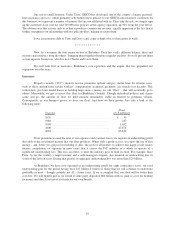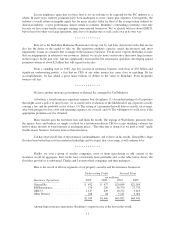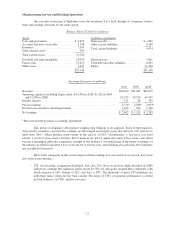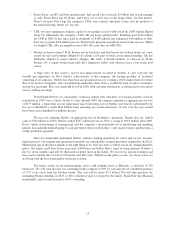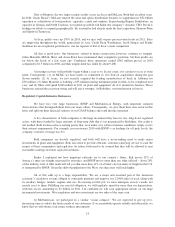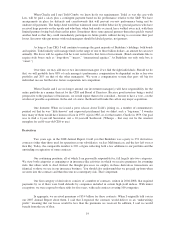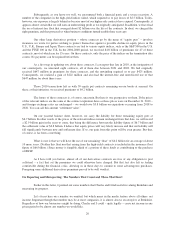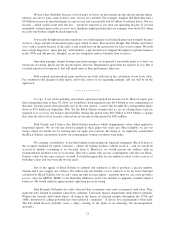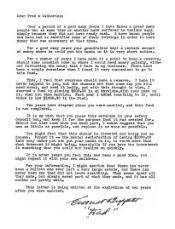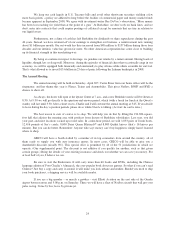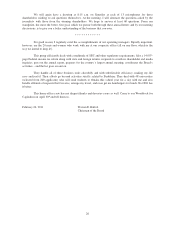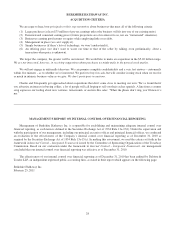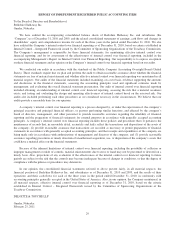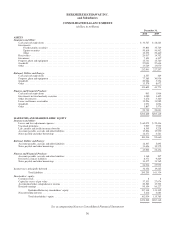Berkshire Hathaway 2010 Annual Report Download - page 22
Download and view the complete annual report
Please find page 22 of the 2010 Berkshire Hathaway annual report below. You can navigate through the pages in the report by either clicking on the pages listed below, or by using the keyword search tool below to find specific information within the annual report.Subsequently, as you know too well, we encountered both a financial panic and a severe recession. A
number of the companies in the high-yield indices failed, which required us to pay losses of $2.5 billion. Today,
however, our exposure is largely behind us because most of our higher-risk contracts have expired. Consequently, it
appears almost certain that we will earn an underwriting profit as we originally anticipated. In addition, we have had
the use of interest-free float that averaged about $2 billion over the life of the contracts. In short, we charged the
right premium, and that protected us when business conditions turned terrible three years ago.
Our other large derivatives position – whose contracts go by the name of “equity puts” – involves
insurance we wrote for parties wishing to protect themselves against a possible decline in equity prices in the
U.S., U.K., Europe and Japan. These contracts are tied to various equity indices, such as the S&P 500 in the U.S.
and the FTSE 100 in the U.K. In the 2004-2008 period, we received $4.8 billion of premiums for 47 of these
contracts, most of which ran for 15 years. On these contracts, only the price of the indices on the termination date
counts: No payments can be required before then.
As a first step in updating you about these contracts, I can report that late in 2010, at the instigation of
our counterparty, we unwound eight contracts, all of them due between 2021 and 2028. We had originally
received $647 million in premiums for these contracts, and the unwinding required us to pay $425 million.
Consequently, we realized a gain of $222 million and also had the interest-free and unrestricted use of that
$647 million for about three years.
Those 2010 transactions left us with 39 equity put contracts remaining on our books at yearend. On
these, at their initiation, we received premiums of $4.2 billion.
The future of these contracts is, of course, uncertain. But here is one perspective on them. If the prices
of the relevant indices are the same at the contract expiration dates as these prices were on December 31, 2010 –
and foreign exchange rates are unchanged – we would owe $3.8 billion on expirations occurring from 2018 to
2026. You can call this amount “settlement value.”
On our yearend balance sheet, however, we carry the liability for those remaining equity puts at
$6.7 billion. In other words, if the prices of the relevant indices remain unchanged from that date, we will record
a $2.9 billion gain in the years to come, that being the difference between the liability figure of $6.7 billion and
the settlement value of $3.8 billion. I believe that equity prices will very likely increase and that our liability will
fall significantly between now and settlement date. If so, our gain from this point will be even greater. But that,
of course, is far from a sure thing.
What is sure is that we will have the use of our remaining “float” of $4.2 billion for an average of about
10 more years. (Neither this float nor that arising from the high-yield contracts is included in the insurance float
figure of $66 billion.) Since money is fungible, think of a portion of these funds as contributing to the purchase
of BNSF.
As I have told you before, almost all of our derivatives contracts are free of any obligation to post
collateral – a fact that cut the premiums we could otherwise have charged. But that fact also left us feeling
comfortable during the financial crisis, allowing us in those days to commit to some advantageous purchases.
Foregoing some additional derivatives premiums proved to be well worth it.
On Reporting and Misreporting: The Numbers That Count and Those That Don’t
Earlier in this letter, I pointed out some numbers that Charlie and I find useful in valuing Berkshire and
measuring its progress.
Let’s focus here on a number we omitted, but which many in the media feature above all others: net
income. Important though that number may be at most companies, it is almost always meaningless at Berkshire.
Regardless of how our businesses might be doing, Charlie and I could – quite legally – cause net income in any
given period to be almost any number we would like.
20


